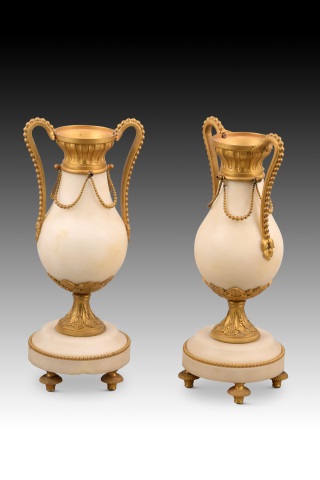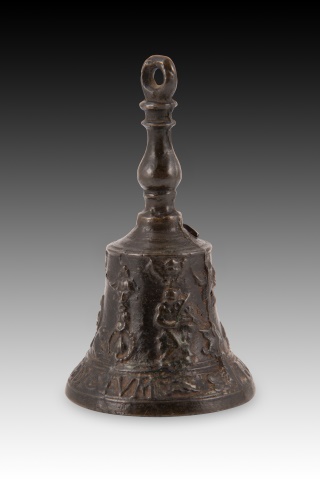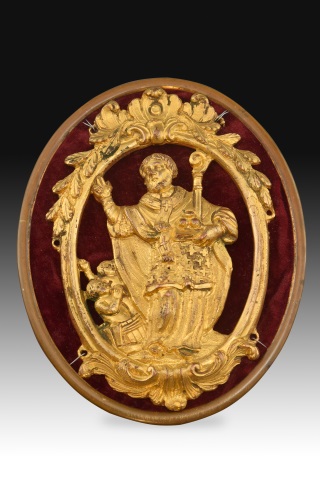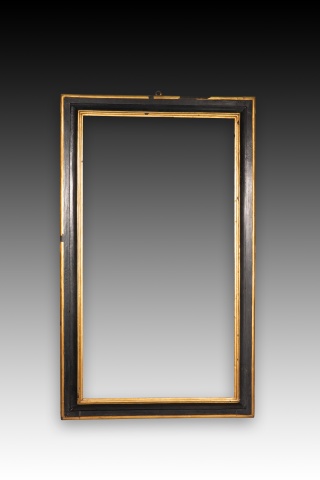
-
Monk's armchair. Leather, walnut wood. Spain, 16th century. Armchair with arms and high backrest of the type known as “friar's chair”, which has leather with studs on the seat and upper part of the backrest, low, cut-out low-profile frames joining the front and back legs and middle frames or side rails (the front one carved and re-cut to create geometric motifs) joining the two front and two back legs, and simple armrests with scrollwork finishes. The friar's chair, originally of Italian origin, became one of the most common pieces of Spanish furniture since its introduction in the 16th century, being characteristic of both the 17th and 18th centuries and being recovered again in the historicist movement of the 19th century. Being such a deep-rooted tradition in Spain, this type of model was never stopped being created.
· Size: 61x54x111 cms.
ANTIQUES
FURNITURE
Ref.: Z0673
-
Bow brooch. Silver, rhinestone. Around the first third of the 20th century. With partial hallmark. Bow-shaped brooch made of silver in its colour with a needle on the back and a composition on the front combining white stones and lines of fine red stones, enhancing the shape and lines of the piece. It is similar to brooches by the firm Collingwood and Sons (Birmingham, England). It has a small partial hallmark on the prong.
· Size: 4x1x2,5 cms
ANTIQUES
MISCELLANEUS;JEWELRY
Ref.: Z4997
-
Peace-bearer. Bronze. 16th century. Peace-holder made of bronze with a flat handle on the back and a slightly raised decoration on the front. Beneath a crown of openwork plant elements in a clear Renaissance style, there is an architectural composition with columns framing a figure of Christ sitting on a throne.
· Size: 7,5x3x10,5 cms
ANTIQUES
MISCELLANEUS;OTHER OBJECTS
Ref.: ZF0538
-
Cupid. Enameled porcelain. Possibly Meissen, 19th century. With sticker on the base. Has restorations. Porcelain figurine with an oval, gilded base on which Cupid is shown lying down, characterised as usual by his wings, bow and quiver of arrows. He also carries a torch and is shown with a garland of leaves. The piece bears strong similarities to figures found on Meissen clocks dating from the 19th century. VL Veneziani was a shop with its main office on Via Frattina in Rome (and another shop on Via Gregoriana) specialising in selling antique and antique-style paintings, furniture and porcelain. Works related to this trade are held in various private collections and in the Fondazione Federico Zeri of the University of Bologna.
· Size: 19x13x20 cms. s/base: 19x12x17 cms
ANTIQUES
PAINTINGS
Ref.: ZF0910
-
Sold

Pair of vases. Bronze, marble. 19th century. Pair of vases made of carved light marble with a stepped, circular base of the same material. They also feature decorative details in gilt bronze (pearl chains, necks with architectural elements, etc.), clearly showing a classicist influence. This type of work was common in Europe during the 19th century, and the strong French influence was also very common.
· Size: 10,5x10,5x27,5 cms.
ANTIQUES
MISCELLANEUS;OTHER OBJECTS
Ref.: ZF1004
-
Inkwell. Glazed ceramic. Talavera de la Reina, Spain, 17th century. A square-shaped inkwell or spice rack made of glazed ceramic with a polychrome decoration of plant elements on the top and fronts. Due to the colours used, it belongs to the so-called tricolour series, which began to be produced in Talavera de la Reina at the beginning of the 16th century and became common even at the beginning of the 18th century. Compare this with the decorations on pieces kept in the Museo Nacional de Artes Decorativas (Madrid, Spain), or in the Museo de Cerámica Ruiz de Luna in Talavera de la Reina (Toledo, Spain).
· Size: 9x9x5.5 cms
ANTIQUES
MISCELLANEUS;CERAMIC
Ref.: ZF1047
-

Hand bell or bell, “from Malinas”. Bronze. 16th century. Hand bell with clapper made of bronze and decorated on the outside with a slight relief. The base has, between bands, an inscription in capital letters and in Latin (“Sit nomen Domini benedictum”, “Blessed be the name of the Lord!”); above it, on the body of the bell, there is a decoration with angels, vases with plant elements, garlands, a figure playing a musical instrument, etc., with a great classical influence; the hand has a balustrade shape with mouldings. The text refers to the Apostolic or Papal Blessing, typical of Catholic liturgy. The export trade of handicrafts and artistic pieces during the 15th and 16th centuries that took place in the Netherlands was of great importance, especially between the territories that were then united under the same crown. Among the pieces (experts speak of almost industrial production) that enjoyed the greatest diffusion were these bells called "de Malinas" because they came from this Flemish city. The success of the model is indisputable and proof of this is that, from imported examples, molds were made with which to obtain absolutely identical copies. These bells usually have common characteristics such as their small size and their beveled profile; however, the peculiarity that easily identifies them is the decoration they have on their surface. Weight: 425 grams.
· Size: 8x8x14 cms.
ANTIQUES
MISCELLANEUS;OTHER OBJECTS
Ref.: ZF1302
-
Oinochoe. Bronze. Possibly Italy, 19th century. An oenochoe, oinochoe, oinochoe or oenochoe is a vessel used to draw wine from a krater (where it was stored) before serving in ancient Greece. Its heyday was during the Geometric period and various types are distinguished according to the shape of the mouth and the belly. Most Greek oenochoes were made of terracotta, but there are also some made of precious metals, presumably for the social classes that could afford them, although very few have survived. The present example seems to be inspired by ancient works (compare one in the Metropolitan Museum from around 460 BC with inventory number 1970.11.1 and another in the Museum of Fine Arts, Budapest with inventory number 66.142.A).
· Size: 12x12x20 cms
ANTIQUES
MISCELLANEUS;OTHER OBJECTS
Ref.: ZF1390
-
Pair of vases. Bronze. Japan, Meiji period (1868-1912). Pair of bronze vases decorated with figurative elements and a band of gadroons. The necks feature two oriental-style dragons in flight, while the bodies depict birds, branches, and fruit in various poses. Stylistically, they are similar to examples in private collections dating to the late 19th century. Weight: 5.45 kg.
· Size: 19x19x32 cms
ANTIQUES
MISCELLANEUS;OTHER OBJECTS
Ref.: ZF1439
-
Peace-bearer. Bronze. 16th century. Bronze peace-bearer with a flat “C” handle on the back, with a relief decoration on the front framed in a classical architectural composition common in the Renaissance. Below the columns on the sides there are two heraldic shields (without a bonnet, cords with tassels on three levels) with a Latin cross in the middle area; the centre shows a Birth of Christ under a domed cupola with winged angel heads in the corners; at the top and under a semicircular arch, there is the bust of Santo Domingo de la Calzada, facing forward, with an inscription in capital letters.
· Size: 10,5x5x15,5 cms.
ANTIQUES
MISCELLANEUS;OTHER OBJECTS
Ref.: ZF0543A
-
Vegetable bowl with lid, Morro Castle, Havana, Cuba. Earthenware. Sargadelos, 19th century. It has minor flaws. Vegetable bowl with handles and a lid on which a landscape can be seen, identified with a text (Morro Castle, Havana, Cuba), enhanced by a border that extends over the edge and continues (but in relief, not in pigmentation) along the handles of the piece; the base also has decoration. The lid has a flower in relief as a finish and a series of decorative borders in a tone matching the rest of the piece. Antonio Raimundo Ibáñez, Marquis of Sargadelos, founded the Royal Pottery Factory of Sargadelos in Cervo, province of Lugo, at the beginning of the 19th century. The view of this piece belongs to the Series of Views of Cuba, used in the factory since 1848.
· Size: 34x26x18 cms
ANTIQUES
MISCELLANEUS;CERAMIC
Ref.: ZF1370A
-
Bullfighting poster, Inauguration of the San Sebastian bullring. Oil on canvas. PÉREZ SAAVEDRA, Manuel (doc. Circa 1903). 1903. Original poster for a bullfighting event for the opening bullfight at the San Sebastián bullring (known as Coso de El Chofre), which was attended by Alfonso XIII. It is a work in a clear Modernist style by Manuel Pérez Saavedra, and this was the original poster for the event. There are references to a Manuel Pérez Saavedra in the documents of the Royal Academy of Fine Arts of San Fernando in Madrid of the Provincial Commission of Monuments of Lugo (minutes of the session, 1921), in the Regional Exhibition of Galician Art of 1917 held in La Coruña, in the catalogue (as a native of Madrid) of the General Exhibition of Fine Arts of 1897, etc.
· Size: 52,5x6x85 cms. Int 37x70 cms
ANTIQUES
PAINTINGS
Ref.: ZF135401
-
"Poster announcing the Bullfight held on the occasion of the marriage of HM King Alfonso XIII to HRH Princess Victoria Eugenie of Battenberg." Framed lithograph. BENLLIURE, Mariano. Spain, 1906. Alfonso XIII can be seen greeting the public from the royal box, accompanied by Victoria Eugenia and a number of figures, below the text, which extends to the right. In the lower area, with ribbons, you can read "Long Live the Queen." The model for this poster was designed by Mariano Benlliure (1862-1947), who already had experience as a bullfighting poster artist. The lithographic artist was Antonio de Ángel Alcoy (circa 1863-1925), and the Litografía Mateu of Madrid was responsible for the production.
· Size: 47x1x68 cms
ANTIQUES
MISCELLANEUS;GRAPHIC WORK
Ref.: ZF135445
-
Cylindrical “turner’s test” box, 17th-18th century. Cylindrical box decorated with different bands and a lid with a carved star. On the base there are a series of inscriptions that allude to the purpose for which it was created: these types of pieces were tests of mastery for apprentice turners, which they had to take in order to pass certain exams within the guild to which they belonged. Many of these works are not preserved because they are more practical than decorative and not commissioned by a client, but their interest is undeniable for this very reason.
· Size: 10,5x10,5x19 cms.
ANTIQUES
MISCELLANEUS;OTHER OBJECTS
Ref.: Z2330
-
Mother-of-pearl box with bronze mount. 19th century. Box made of mother-of-pearl plates joined together by a bronze structure decorated with simple plant elements and which still retains traces of gilding in some areas. The shape of the piece is reminiscent of examples inspired by the French Louis XV style, while the materials used were common in the decorative arts of the 19th century.
· Size: 7,5x5,5x4 cms.
ANTIQUES
MISCELLANEUS;OTHER OBJECTS
Ref.: Z3817
-
“Catavinos” or bernegal. Silver. 20th century. Vessel of the type known as “tembladera” with two circular handles decorated with very simplified plant elements and a scalloped body reminiscent of the pieces called “de bocados”. Bernegales and tembladeras de bocados were frequent pieces in Spanish silverware in the 17th century, usually being relegated to centres of somewhat less importance in the 18th century. During the 19th and 20th centuries, it was common in silverware and the rest of the arts to be inspired by styles of the past for the creation of numerous pieces, such as this one. Weight: 151 gr.
· Size: 15x11,5x7,5 cms.
ANTIQUES
MISCELLANEUS;SILVER
Ref.: Z5830
-
Acetre. Bronze. 16th century. Bronze piece with a circular base and a circular body with a mouth that extends outwards at the top and a relief decoration in this last area with masks that recall certain Renaissance pieces with Medusa (the rings for the handle emerge from two of these elements). This acetre, a vessel for holy water also known as a situla, is a piece that, in this religious context, appeared in the West in the Middle Ages. The present example is inspired by Renaissance pieces both in its lines and its decoration and, therefore, is also reminiscent of works from Ancient Rome (situla from the Landesmuseum in Hannover, etc.).
· Size: 19x18x19 cms.
ANTIQUES
MISCELLANEUS;OTHER OBJECTS
Ref.: Z5937
-
Stool. Walnut wood. 18th century. Rectangular bench with smooth moulding on the edge and turned baluster-shaped legs, which are secured in the lower area by means of cut-out profile jambs on the bottom. It shows classicist influences, present together with traditional elements of older Spanish furniture (format, construction, etc.).
· Size: 52x34,5x50 cms.
ANTIQUES
FURNITURE
Ref.: ZE331
-
Door knocker. Wrought iron. 16th century. Door knocker made of wrought iron and made up of several pieces, among which the main one stands out. It has two bands that start in parallel and then separate to form two facing volutes joined in this area by a rectangular piece, also showing several engraved lines that highlight these elements. The use of wrought iron volutes was common since Romanesque times, and we can speak of an evolution in this element over time. The present example belongs, due to its shape, to a type of handle or knocker known as “scissor”.
· Size: 15x8,5x2 cms
ANTIQUES
MISCELLANEUS;OTHER OBJECTS
Ref.: Z0007A
-
Espagnolette. Wrought iron. 18th century. An iron element made up of several pieces firmly joined together, with simple decoration based on rings and other details, used to close a door or window. This type of piece was very common in the construction of important residences. 2 pcs available.
· Size: Longitud 205 cms.
ANTIQUES
MISCELLANEUS;OTHER OBJECTS
Ref.: Z3485B
-
Axe. Wrought iron. 20th century. Tall wrought iron torch holder with a tripod base formed by scrolls and a triangular piece from which the axis emerges (with a balustrade profile with discs). This ends in a plate from which an openwork piece starts that would hold the candle. The scrolls, the lines of the axis, simplified plant details, etc. show a clear influence of ancient works, especially from the Baroque of the 17th century. This inspiration is frequent within the framework of Historicisms.
· Size: 38x38x133 cms
ANTIQUES
MISCELLANEUS;OTHER OBJECTS
Ref.: ZF0310
-

Devotional medal of Saint Nicholas on a support. Gilt bronze, textile, metal. 18th century. Devotional medal in gilded bronze placed on a support with wires that presents an oval frame enhanced with a crest with vegetal elements in a symmetrical composition and another top below also with vegetal elements and scrolls, and the figure of a saint inside this smooth frame. Standing, holding a staff in one hand and raising the other in a gesture of blessing, is a male figure dressed in liturgical attire, accompanied by some small figures praying, placed in a barrel or bucket. Saint Nicholas of Myra or Bari was a bishop who died around the middle of the 4th century AD. One of his most famous miracles was that of resurrecting three children (shown in this work) sacrificed by an innkeeper to feed his clients. Although he was bishop of the city of Myra, he is shown here wearing liturgical vestments but without the usual headdress (mitre). The three spheres that appear on the book would allude to the miracle in which the saint helps the father of three girls to gather a dowry for them (as they are three golden spheres).
· Size: 9x11,5x1 cms.
ANTIQUES
SCULPTURE
Ref.: ZF0460
-
Jug and glass. Glass. Royal Glass Factory of La Granja de San Ildefonso, Segovia, Spain, 18th century. Jug or vase with lid and glass with a small spout made of clear, carved and engraved glass, decorated with plant elements and architectural motifs of classical influence. They were made in the Royal Glass Factory of La Granja de San Ildefonso, founded in 1727 by Buenaventura Sit and, initially, as a furnace for flat glass to supply the nearby Royal Palace. Shortly after, they would diversify their production, becoming one of the main centres in Spain.
· Size: Jarra 10x10x33 cms. Vaso 13x13x15 cms
ANTIQUES
MISCELLANEUS;OTHER OBJECTS
Ref.: ZF0878
-
Sold

Frame. Carved, polychrome, and gilded wood. 18th century. It has faults. Rectangular frame made of carved wood with a black area flanked by two gilded areas on the outside and inside of the piece, with a flat area in both colors and a different one, again in both finishes. Stylistically, it recalls examples common in numerous European schools since the Renaissance.
· Size: 85x6x140 cms. Int 68x123,5 cms
ANTIQUES
MISCELLANEUS;FRAMES
Ref.: ZF1338